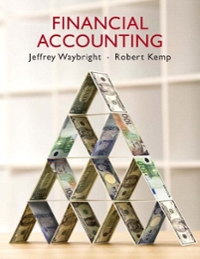I need help answering the attached question. Thank you.
Present Value of $1 Due in n Periods* EXHIBIT 26-3 Number of Discount Rate Present Value of $1 Payable Periods in n Periods (n) 1% 11/2% 5% 6% 8% 10% 12% 15% 20% CO NO UA W N- 990 .985 .952 943 926 909 893 870 .833 980 .971 907 890 .857 .826 .797 .756 .694 .971 .956 .864 840 .794 .751 712 .658 .579 .961 .942 .823 .792 .735 .683 .636 .572 .482 .951 928 .784 .747 .681 621 567 497 .402 942 915 .746 705 .630 564 507 .432 .335 933 .901 .711 665 .583 513 .452 376 .279 923 .888 .677 627 .540 .467 .404 .327 .233 9 914 .875 .645 592 .500 .424 .361 284 . 194 10 905 .862 .614 558 .463 .386 .322 247 162 20 .820 .742 .377 312 .215 . 149 .104 061 .026 24 788 700 .310 247 . 158 . 102 066 035 013 36 .699 .585 .173 . 123 .063 .032 .017 .007 .00 1 "The present value of $1 is computed by the formula p = 1/(1 + ijn, where p is the present value of $1, / is the discount rate, and n is the number of periods until the future cash flow will occur. Amounts in this table have been rounded to three decimal places and are shown for a limited number of periods and discount rates. Many calculators are programmed to use this formula and can compute present values when the future amount is enteredPresent Value of $1 to Be Received Periodically for n Periods EXHIBIT 26-4 Number of Discount Rate Present Value of a $1 Annuity Periods Receivable Each Period for n (n) 1% 11/2% 5% 6% 8% 10% 12% 15% 20% Periods GODYOUAWN- 0.990 0.985 0.952 0.943 0.926 0.909 0.893 0.870 0.833 1.970 1.956 1.859 1.833 1.783 1.736 1.690 1.626 1.528 2.941 2.912 2.723 2.673 2.577 2.487 2.402 2.283 2. 106 3.902 3.854 3.546 3.465 3.312 3.170 3.037 2.855 2.589 4.853 4.783 4.329 4.212 3.993 3.791 3.605 3.352 2.991 5.795 5.697 5.076 4.917 4.623 4.355 4.111 3.784 3.326 6.728 6.598 5.786 5.582 5.206 4.868 4.564 4.160 3.605 7.652 7.486 6.463 6.210 5.747 5.335 4.968 4.487 3.837 8.566 8.361 7.108 6.802 6.247 5.759 5.328 4.772 4.031 9.471 9.222 7.722 7.360 6.710 6.145 5.650 5.019 4.192 20 18.046 17.169 12.462 11.470 9.818 8.514 7.469 6.259 4.870 24 21.243 20.030 13.799 12.550 10.529 8.985 7.784 6.434 4.937 36 30.108 27.661 16.547 14.621 11.717 9.677 8.192 6.623 4.993Toying With Nature wants to take advantage of children's current fascination with dinosaurs by adding several scale-model dinosaurs to Its existing product line. Annual sales of the dinosaurs are estimated at 80,000 units at a price of $6 per unit. Variable manufacturing costs are estimated at $2.50 per unit, Incremental fixed manufacturing costs (excluding depreciation) at $45,000 annually, and additional selling and general expenses related to the dinosaurs at $55,000 annually. To manufacture the dinosaurs, the company must invest $350,000 in design molds and special equipment. Since toy fads wane In popularity rather quickly, Toying With Nature anticipates the special equipment will have a three-year service life with only a $20,000 salvage value. Depreciation will be computed on a straight-line basis. All revenue and expenses other than depreciation will be received or paid In cash. The company's combined federal and state Income tax rate Is 40 percent. Required: a. Prepare a schedule showing the estimated Increase in annual net income from the planned manufacture and sale of dinosaur toys. b. Compute the annual net cash flows expected from this project. c. Compute the following. Assume discounted at an annual rate of 15 percent. Use Exhibits 26-3 and 26-4 where necessary. (1) Payback perlod (2) Return on average Investment (3) Net present value Complete this question by entering your answers in the tabs below. Required A Required B Required C Prepare a schedule showing the estimated increase in annual net income from the planned manufacture and sale of dinosaur toys TOYING WITH NATURE Schedule of Estimated Net Income Less estimated incremental costs Income before income taxes Estimated increase in annual net income 0 Complete this question by entering your answers in the tabs below. Required A Required B Required C Compute the annual net cash flows expected from this project. Annual net cash flow Complete this question by entering your answers in the tabs below. Required A Required B Required C Compute the following. Assume discounted at an annual rate of 15 percent. Use Exhibits 26-3 and 26-4 where necessary. (Round your "PV factors" to 3 decimal places, payback period to the nearest tenth of a year and the return on average investment to the nearest tenth of a percent.) (1) Payback period years (2 Return on average investment (3) Net present value










